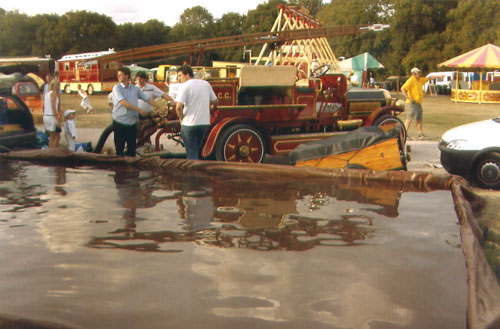

The Club was founded in 1909 and was called the Portsmouth Model Steam Boat Club. The Canoe Lake at Southsea was, and still is, the home water. The boats were mostly steam with a few electric or petrol powered, the steam boats using petrol blowlamps to heat the boilers. Speed Competitions were held with boats timed over a measured distance. The steam boats were usually fastest.
Steering competitions were also held where boats were aimed at a set of six flags on the far side of the lake, the boats getting closest to the middle pair scoring the highest points. No radios in those days! As the boats became faster it was decided to race on a circular course with the boats attached by a wire to a pole fixed in the middle of the lake. The first event of this kind at the Canoe Lake took place in June 1921 The quest for speed led to the construction of Steam Hydroplanes, and in 1922 the Steam Hydroplane “Planus 11 recorded a speed of 13.75 mph in the over 20lbs and under 30lbs class (9 to 13 kg).
 Flash steam was becoming popular as the boiler weighed much less and the steam pressure was higher thus allowing the boats to go much faster. By 1927 the speed had risen to 25.6mph
By this time petrol powered boats were becoming faster and in 1929 a steamer, Peg, reached 33.48mph and a petrol powered boat, Vagabond11, came second with a speed of 19.5 mph.
The interest in scale boats continued to remain high using mainly steam power. Electric power was also used in scale boats as the weight of the large lead acid batteries was not so important.
Flash steam was becoming popular as the boiler weighed much less and the steam pressure was higher thus allowing the boats to go much faster. By 1927 the speed had risen to 25.6mph
By this time petrol powered boats were becoming faster and in 1929 a steamer, Peg, reached 33.48mph and a petrol powered boat, Vagabond11, came second with a speed of 19.5 mph.
The interest in scale boats continued to remain high using mainly steam power. Electric power was also used in scale boats as the weight of the large lead acid batteries was not so important.
In 1945 the Steam Boat Club amalgamated with the Portsmouth Society of Model Engineers. In 1949 the club broke away from the Engineers and became The Portsmouth and District Model Power Boat Club. The boats were mainly scale models with petrol and diesel engines starting to become popular. Speed still played a large part in the club activities with Portsmouth boats featuring high in many result tables at home and abroad in the next twenty years.
Steam had become less popular as Petrol, Diesel and Glow Plug engines were developed and produced more power. Radio control was beginning to become popular in the early 1960s and steering competitions were introduced, with boats being steered round a course marked out with buoys. The club still has a good steam boat following, with a number of members running steam boats, and one member making his own engines and boilers. The majority of models now are electric powered with the advances in small high powered electric motors and Ni cad and now Ni-MH batteries with their light weight and high power output make electric boats quiet and convenient to use.
The club attends many events in the south ranging from Z Class Regattas, Steam Rallies, Model Exhibitions and School Fayres. We have a portable pool, which we can take to events to allow the boats to be demonstrated on the water.

*This old fire engine is a 1909 Dennis owned by a London collage, the students drove the engine down from London for the event. The photo was taken at the Havenstreet Steam Extravaganza and shows the fire engine pumping out our pool at the end of the rally.
To see the gallery of Jim's Scrapbook - a fascinating collection of press articles and images related to the history of PDMPBC from nearly 100 years ago - please click here.
To download the complete scrapbook with high quality images in a .zip format please click here. Please be aware this is a large 28.3MB file and may take several minutes to download.